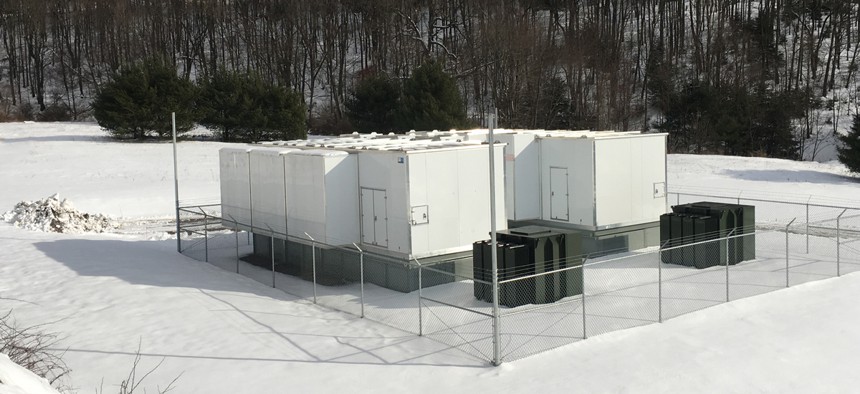Energy
Microgrids bringing maximum impact to PA’s energy landscape
Localized distributed energy systems are helping protect Pennsylvanians against power outages and high energy costs.

In Somerset County, Berlin Borough installed a diesel-powered generation system. PowerSecure
In communities across Pennsylvania and the continental U.S., microgrids are now more than just an innovation in the energy space – they’re proving to be an essential tool for keeping the lights on.
That was the case in 2022, when Hurricane Ian left more than 2 million people without power across Florida, Georgia, Virginia and the Carolinas – however, some residential communities, as well as a hospital and a university, were able to keep their facilities powered – thanks to microgrids. And in Puerto Rico, the devastation caused by Hurricane Maria in 2017 has prompted the municipality of Adjuntas to explore a community-owned microgrid to boost energy resiliency.
In Pennsylvania, there are at least 16 operational microgrids – self-contained energy networks that distribute and generate on-site power through a variety of energy sources and technologies, ranging from combined heat and power and diesel to natural gas to solar energy.
The Philadelphia Navy Yard employs a natural gas-powered microgrid, but perhaps the most well-known microgrid in the state is the one that powers Pittsburgh International Airport – making it the first airport in the world to be powered by a combination of solar energy and natural gas.
These localized, distributed energy systems – which the U.S. Department of Energy’s National Renewable Energy Laboratory defines as a “group of interconnected loads and distributed energy resources that acts as a single controllable entity with respect to the grid” – are being increasingly relied upon to power everything from communities, schools and academic institutions to hospitals and airports.
Jim Freihaut, a professor of architectural engineering at Pennsylvania State University who also directs the U.S. Department of Energy’s Mid-Atlantic Combined Heat and Power Technical Assistance Partnership, told City & State that communities, companies and other entities are increasingly developing their own localized, on-site energy systems – or microgrids – in an effort to lower their greenhouse gas emissions and save money on energy costs.
“You see more and more people looking at on-site energy systems, especially for government facilities,” he explained. “You see companies looking at it now, industries and manufacturers … and rural electric co-ops looking at it more and more, and I think it’s probably a good way to go.”
Microgrids can lower costs for energy users since they can be used to generate and distribute electricity during times of peak energy demand.
Such localized energy systems can also generate revenue – any excess energy can be sold to the main grid – or distributed to nearby communities, which Freihaut said could help communities without microgrids during power outages.
Freihaut said the development of microgrids, which can connect and disconnect from larger grids at will, could help the U.S. better protect against both extreme weather events and cyberattacks, as areas with microgrids can generate and store their own power.

The Pentagon has also looked to microgrids to power more than 130 U.S. Army bases, and has even recruited hackers to try to identify and address any vulnerabilities that could expose microgrids to cyberattacks, according to the website CyberScoop.
Freihaut pointed to a two-microgrid project he worked on in Montgomery County, Maryland that is used to power the county’s correctional facility and public safety building. A case study conducted by Schneider Electric, which built and maintains the microgrids, states that when the county experiences power outages, the microgrids can separate from the larger grid and keep public buildings powered.
“Having the microgrids will give the county an edge when the next big storm hits. Microgrids typically run in parallel with the utility grid, but when a power outage occurs, the microgrids will island from the grid,” the case study reads. “Protected from the grid disturbance, the microgrids will then power the correctional facility and public safety headquarters with its on-site resources, in this case solar, trigeneration, and natural gas generators.”
Freihaut also noted that microgrids that utilize natural gas generators can be retrofitted to use renewable sources in the future. “All these gas turbines that are being manufactured now, all the internal combustion engines that have been manufactured now for generating electricity and heat locally – those all have the capability (of using) blends of renewable natural gas and hydrogen. And that’s not a big economic strain,” he said.
But you don’t have to look outside of Pennsylvania to see microgrids in action.
The Philadelphia Navy Yard has been dubbed an “unintentional” microgrid – it was developed after the federal government in the 1990s decided to shut down the naval shipyard – and most of the electrical services on the 1,200-acre plot of land.
Now, the shipyard features a six-megawatt natural gas-fired peaking plant designed to run during the Navy Yard’s peak demand periods and during times of high energy costs. The plant also allows the Philadelphia Navy Yard to participate in the ancillary service market run by PJM, the regional transmission organization that coordinates the movement of wholesale electricity throughout 13 states and Washington, D.C.
In Allegheny County, Pittsburgh International Airport’s microgrid went live in 2021, making history in the process as the first microgrid in the world to power an entire airport. It’s powered by 10,000 solar panels and five natural gas generators, and when the microgrid officially launched, Christina Cassotis, CEO of the Allegheny County Airport Authority, said in a statement that the “Pittsburgh International Airport is now one of the most site-hardened public facilities in the world while at the same time becoming more sustainable.”
In addition to the more high-profile microgrids in Philadelphia and Pittsburgh, smaller communities, like the boroughs of Quakertown and Berlin, have turned to microgrids as well.
In 2016, officials in Berlin Borough in Somerset County approved and broke ground on a $2.55 million diesel generator project that can provide up to 3.75 megawatts of diesel electric generation to the borough. Berlin can now tap into the diesel-generated power in times of peak energy use; the generators are turned on approximately six times per year when electricity costs are high enough to warrant the usage. The generators also serve as a backup power source for when the borough loses power.
The impetus for the microgrid can be traced to the 2014 polar vortex, when Berlin officials received a wholesale electric bill that was nearly double what the borough usually paid during the same billing period.
The borough entered into a $2.2 million contract with the North Carolina-based distributed energy company PowerSecure in 2016, which continuously monitors the borough’s generators and microgrid.
By using the generators during times of peak energy usage, the borough sees roughly $300,000 in net annual savings. According to PowerSecure, which engineered, built and installed the diesel-powered Tier 4 Final PowerBlock generation system, onsite microgrids allow customers to switch to “island mode” as needed, which separates the microgrid from the larger grid, thereby reducing utility loads.
“Installing the generators to take advantage of peak load-shaving was the best opportunity available for the Borough to minimize the ever-increasing capacity and transmission charges for purchased power,” Berlin Borough Executive Secretary Traci Horning told City & State in a statement.
For microgrids to become more commonplace in the U.S., Freihaut said, the federal government should be making it more attractive to build and operate microgrids.
“Everyone gets very excited because it’s going to reduce their carbon footprint. Then they ask for the costs. Well, it costs us a lot more upfront. It’ll take you four, five, six years to get your money back from your energy savings. That’s a little bit too long for most people … and then the green in their wallet is more important than the green of the environment,” he said, adding that “It’s a reason why the government should be incentivizing these things – it’s a societal benefit for this to happen.”
